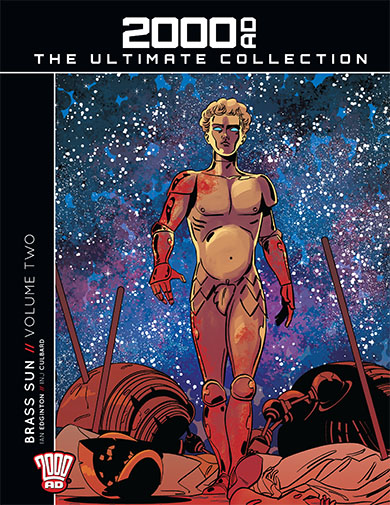2000 AD: The Ultimate Collection #123. Originally serialised in 2000 AD Progs 1888-1899, 1950-1959 & 2061-2072.
It’s July 2014. The first collection of Brass Sun brought us a series that played with a lot of adventurous hero’s-journey type tropes as plucky young Wren and her cloistered sidekick Septimus rode the rails of a huge clockwork orrery solar system searching for parts of a key to save the world. But there was always a slightly dark undercurrent to those first two stories, and in this second (and so far, final) Volume we take more than one surprising left turns.

The successes of the first two arcs are still present in this collection of the following three stories – engaging characters, a fantastic high concept, fast-paced world building, and INJ Culbard’s excellent art and design. But the overarching plot presses forwards in unexpected ways, as Wren and Septimus are really out through the wringer both physically and emotionally.
The hand of the creator, the Blind Watchmaker, becomes a lot more human and grounded as Wren gets to have chats with a version of him in her head that looks and sounds like Kurt Vonnegut. 2000 AD has never gone far wrong questioning authority, and it’s a nice progression in the series that the Watchmaker wasn’t/isn’t some all knowing mastermind but a flawed being who made mistakes and tried to make the best of it. It’s a tried and true storytelling approach, but it’s a great counterpoint the intricate precision of the Orrery itself (even as this begins to fail). Humans are gonna human, and even in this high-concept future world we still have people using faith to twist their own worlds around themselves.

Writer Ian Edginton takes some really interesting approaches to story and adventure in this collection as well. Wren’s experiences (torture at the hand of monstrous nuns and being hunted by implacable monsters) force her to stop and actually consider her place in the story. It’s tricky to have the lead in your adventure quest series throw up her hands and go “I’m out”, and mean it, but I really like how Edginton gets us there. Wren was pitted against structural forces that have a lot more power than her, and it’s those in charge that have created and embedded the disasters facing them all. Wren’s frustration with the scale of the world-ending challenge reads even more intensely here in 2024, as powerful forces resist action on climate change.
It does make for a much tougher read than the first Volume, as the gloss of high adventure falls away and awful things happen to the characters. Wren and Septmius’s relationship is a particularly tragedy, with a sudden swerve and time jump in Engine Summer (2017) leaving them seemingly on opposite sides. Just as Edginton subverts the typical quest narrative, the budding romance between the two young leads goes in a very different direction than you would expect.

My membership of the INJ Culbard fan club is now well established on this blog, so I don’t need to go into too much extra detail here. The expansion of the scope of the series gives him plenty to chew on from an artistic perspective, from the giant fish and creatures of Hot Air, the mental New York of Wren’s brain, and the changed characters of Wren and Septimus over the course of the three stories. He’s still able to convey the wide sense of world and design that the series depends on.
Brass Sun remains a firm favourite of mine from this modern period of 2000 AD. It’s reliance on big ideas and engaging characters is a great reflection of why the comic is still relevant today, and is a wonderful showcase for both Edginton and Culbard’s storytelling skills. The major drawback for this collection is that there’s no more! Here’s hoping we get to head back to the Orrery at some point.
Next time: The disaster squad of distinction gets the spotlight in Ro-busters: Volume One.
